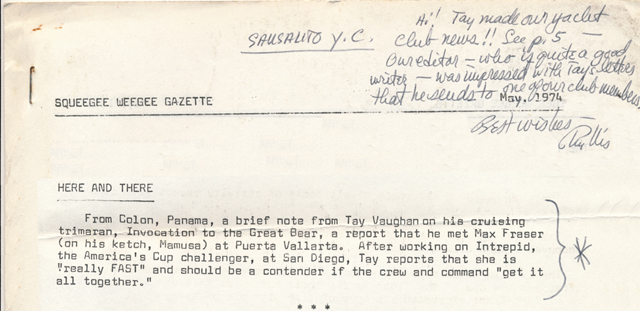|
Vaughan Family Timestream® Maps |
| Home Biography People Places Multimedia: Making It Work On the Water Writings/Presentations |
Captain's Log
For the Sausalito Yacht Club Bulletin, Spring, 1974

We left Sausalito at 0400 on October 10, 1973, heading out through the 'Gate in one of those heavy, thick and windless summer fogs. There were no photographers, no reporters, and no fuss. We went out subdued and serious, thinking ahead to the thousands of cruising miles between us and the Atlantic Ocean. In company were two other yachts; our "running mate" Shearwater and the Socio, a large ketch piloted by Ted Beacon. Ted had offered to guide us to Main Ship Channel Buoy #8 by radar, and we had gladly accepted. By 0700 we were feeling our way south to Santa Cruz, but the trip to Buoy #8 deserves some attention.
Despite radar reflectors all around, big shipping was a definite worry much alleviated by using VHF channel 13 for continual updates from the new traffic center. At one time we were cautioned by a pilot aboard a large freighter to hold station while he cut between us and the Socio en route under the Bridge.
There are few sensual experiences to compare with the muteed pulse of an invisible freighter passing close at hand in the foggy blackness. You grab the tiller a little tighter, lean forward, look around as the tiny cones of your running lights reach into nothingness.
While the Farallon beacon was always strong, we had trouble with the Superbuoy and Bonita, and we ended up using KABL (while listening to "easy rock") for cross fixes with the Farallones. Indeed, the Farallones is so strong we were picking it up in the Santa Barbara Channel some days later. We relied a great deal on the sounder, running the 30-fathom curve until until the fog cleared near Davenport.
We spent eleven days in Santa Cruz to polish up things, putting another coat of non-skid on the cabin top, trading our Sportyak for a larger dinghy, visiting with friends. The entrance had not shoaled in (a problem in the winter) but when a souther came through we saw coamers breaking all the way across the harbor mouth... It cost ten cents per foot per night for a berth at the public marina, and the showers and facilities are clean and good. Santa Cruz seems to be one of those rare places where most of the boats were sailed as often as possible, and where yachtsmen took pride in what they did and how they did it. The chandlery had all the N.O. charts and pilots from San Diego southward and said there was a brisk business in these items.
A quick run to Monterey where we waited out a nasty gale tied up Mediterranean style -- stern to the wharf with a long-roded bow anchor, and despite occasional surge, it was a fine arrangement. Weather broadcasts for the Monterey Bay area are sent on WX2 and we are crystalled only for WX1. The Coast Guard Group Monterey provided us with new weather updates as we prepared to leave Monterey and was exceptionally friendly and helpful.
From Monterey to Morro Bay was our best sail. The winds were 2O knots when we beat out of the harbor and around Cypress Pt. What a pleasure it was to change course 90 degrees and have the wind behind. No more spray, no singing in the rigging, no knives and forks rattling in their drawers. Just the rhythmic lifting, the surf ride, the slowdown and then again... We ran under reefed main and staysail until 0230 when we pulled down the main altogether. The winds had picked up and surfing through the night at sometimes 15 knots was really too much. At daybreak we spoke a Coast Guard cutter searching for the Buenas Dias. She was found some five miles further at sea and was towed to Morro Bay with a broken rudder. At noon we got a good fix on Hearst Castle and by 1630 we were inside Morro Bay. What an entrance'!
We were wing and wing right up to Morro Rock when, about one-half mile off we lowered the staysail and turned on the engine. Under Genoa alone we surfed right around the breakwater and into the protected outer bight. A minute later the engine stuttered and quit, (dirt in fuel), and we still had. three-quarters mile of narrow channel to negotiate. With gusty winds we clawed our way up channel, coasted in between some commercial fishing boats, and dropped a 20lb Danforth which held for about three minutes -- long enough to give us that "Ah, safe" feeling. Then we started dragging across the channel and jumped to rigging the second, heavier anchor. The Port Captain of the yacht club came out in a runabout and yelled through the gusts not to bother because no anchor holds in. the Morro Bay bottom... he would take us to a club buoy. He said last time a visitor insisted stubbornly that his CQR held in anything, the boat in question found itself on top of a dock uninvited.
The Morro Bay Yacht Club deserves highest praise, for they are hospitable and helpful to all who pass through, and one look at the register tells that many well-known cruising boats find haven behind Morro Rock. The Club has room for two, or at most, three boats alongside. The rest go to moorings. We spent three hours digging in the Pacific surf and came back to the fireside, hot showers, and galley of this unpretentious yacht club to cook a chowder of the finest and largest Pismos we had ever seen. It was in Morro Bay that we christened "the clapper", a fine crab net presented us by John Ward before departure. Crab meat is delicious, but be sure to cook them outdoors!
The trip around Conception to Santa Barbara was a disappointment Having steeled ourselves to a hard and windy run with reefed sails and pounding hearts, we found ourselves eight miles off the "Cape Horn of the West" with better than 700 sq. feet of sail flogging limply, deciding finally to turn on the motor and make Santa Barbara before midnight. At dark Shearwater radioed that they had a broken engine mount. -- an aluminum alloy plate had fatigued. We took them in tow until, coincidentally, we cracked a weld in the belt. drive system of the 'Bear. Our problem was curable with a couple of angle irons and nuts and bolts, and it was jury rigged within an hour. Then tragedy! David had rowed over from the Shearwater with his tools, drills, and all things perhaps necessary, and as he stepped into the dinghy to return he was caught by a swell and capsized, sending everything 250 fathoms deep. Never be deceived by a glassy calm sea, and when fatigued, double- think every movement..
Shaken by this accident we proceeded with the tow to Santa Barbara where a Harbor Patrol boat guided the Shearwater to an end-tie. In the morning we discovered that our trip past Coal Oil Point had left the first six inches above t.he waterline covered with thick deposits of crude oil. It seems there is a rather inconvenient natural oil seep to the west of Santa Barbara.
Repairs were made and we left for Avalon Bay, overnighting at Smuggler's Cove on Santa Cruz Island. At Avalon it cost us six dollars per night to use a mooring buoy, and showers at the bathhouse were one dollar more. We decided one night was plenty and the next day readied the "Bear for the 14-hour sail to San Diego. When we went to settle accounts at the Harbor Master's office we were told "That will be twelve dollars even." True to Los Angeles form, there is a "check-out" time, and one must be away from his mooring by 0900 to avoid paying the upcoming night's fee.
The 70 miles from Avalon to Point Loma we covered at night with a lovely 10 knot wind from the southwest. At 0330 we were spoke from the bridge of a large vessel crossing ahead of us, and for twenty minutes until she was again at the horizon, we communicated with blinking Aldis lamps. The verb "communicate", however, is misplaced. We simply couldn't seem to interpret her signals, and then when we finally signalled "RADIO - CH 16 OR 2182," we received no response. It was disappointing, and he was still blinking when we lost sight. At 0415 we were keeping an eye on an irregularly flashing strobe some distance ahead and to starboard when there was a brilliant but noiseless flash directly overhead. Startled the hell out of us. We radioed Coast Guard Long Beach and were informed of naval maneuvers in the area (we were some 35 miles NW of Point Loma); they said to proceed on course.
Since our arrival in San Diego we have learned. that we chanced on submarine training maneuvers and a search plane had picked us up on radar. As a small wooden boat we had given a response similar to a submarine snorkel and the searchplane had simply taken a photograph. The strobe was a sonar buoy dropped to relay information aloft. We were glad when the sun came up.
San Diego is a very well-kept and clean city, and the Bay is pristine compared to San Francisco's. There is a very active Harbor Police Department which makes patrol rounds, and small boat operations in the bay seem well-organized and controlled. Anchoring is permitted only in a very few crowded areas and only when the vessel is equipped with an approved holding tank. Tie-ups are available at the yacht clubs and marinas, and if it's off-season, there is usually room.

